The Minideck
Before I can explain the Minideck, let me tell you about the Everdeck. The Everdeck is 120 cards “designed with a ruthless combinatorial efficiency” to be useful in playing and prototyping a variety of games.1 It maps to many existing decks and even includes provisions for Scrabble-like word games and cartomancy.
I wanted to make something like that, but with only 18 cards. Why?
- I knew someone excitedly working on Buttonshy’s 18 Card Challenge last year. I haven’t stopped turning it over in my head since.2
- The Everdeck is free, but it’s a lot to print yourself.3 18 cards is only two sheets of paper.
- The challenge! 18 has only 5 divisors compared to 120’s 15. This is the same number of divisors as 52, in fact, but crucially it is not divisible by 4. Being a much smaller number, there is also less “room” to delegate systems to different sub-sets of cards.
The Cards
A single card from the Minideck looks like:
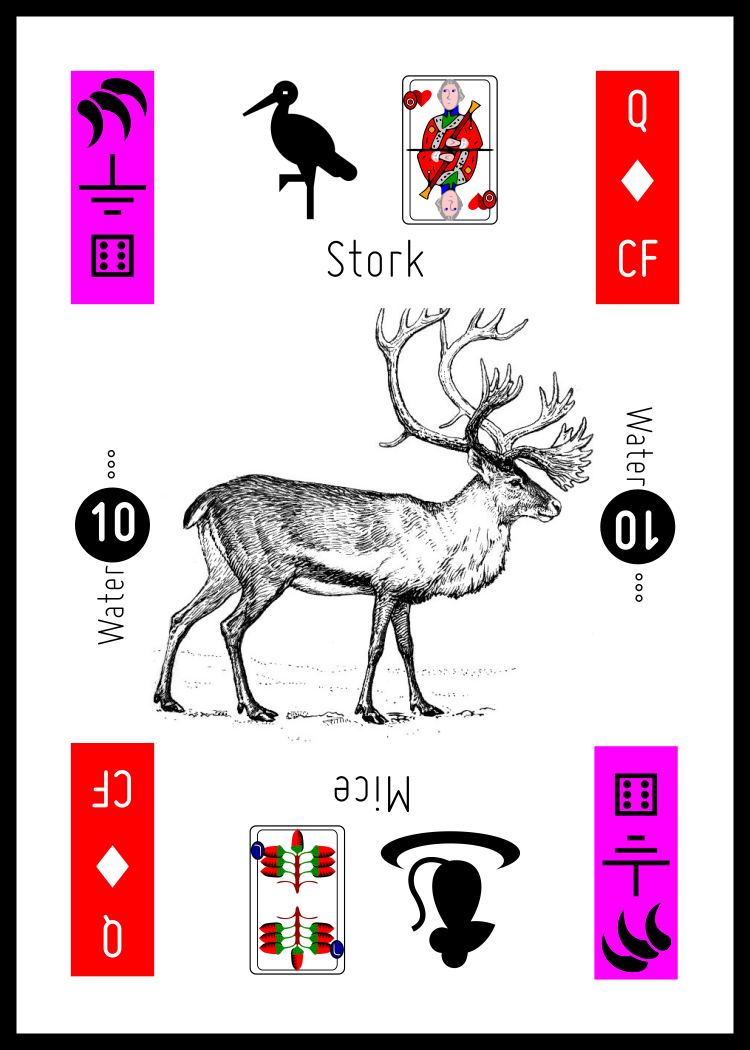 Card 10.
Card 10.
The Sidebar
 The Sidebar.
The Sidebar.
Sequence
Each card has a unique number from 0-17 in a black circle on the center of the left and right sides.
Type
There are very few sets of 18 things, but there are 18 Pokémon types. They are assigned to cards by matching index number to sequence, even where this doesn’t make intuitive sense with other information on the card. To make the most use of them, a type chart may be desired.
Pips
Eleven cards have 1-4 pips on them. This subset of cards can be used to play Pico 2.
The Left Cartouche
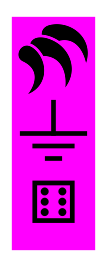 The Left Cartouche.
The Left Cartouche.
The left-hand cartouche contains information relating to the division of the deck into thirds. It also determines the central illustration.
Shape
The left cartouche shares a shape with the right cartouche, kiki or bouba.
Domain
Each card has an association with a domain. The three domains are sky (), land (
), and sea (
). The domain determines the color of the left cartouche: yellow (sky), magenta (land), or cyan (sea). For simplicity though, the “color” of a card always refers to the color of the right cartouche (red or black).
If you divide the cards into three decks by domain, the sequence numbers behave as rolls from a set of permutation-fair go-first dice.4 Which is to say that any order from highest-to-lowest of the top card from each deck is equally likely. Note that this property is not guaranteed for partial decks (e.g. after the first draw).
Kingdom
Each card also has a kingdom below the domain. The three kingdoms are animal ( ), vegetable (
), and mineral (
).
If you divide the cards into three decks by kingdom, the sequence numbers behave as rolls from a set of three intransitive dice.5 In general, the animal deck is stronger than the vegetable deck is stronger than the mineral deck is stronger than the animal deck, all with probability 7/12. As with the domain, this property is not guaranteed for partial or unrandomized decks.
Roll
The left cartouche also contains one face of a six-sided die. If you divide the cards into three decks by kingdom or domain, each deck has one of each face from 1-6 (and so a draw from one of these full, shuffled decks can simulate a die roll).
To allow this, the roll cannot be exactly random: each pair of matching cards must have one of two pre-defined rolls in order to preserve this symmetry. Which card has which roll was chosen to keep different rolls between otherwise similar cards. But the rolls were “shuffled,” which is to say, assigned in a random order. The hope is that this prevents clustering of roll values by other properties, and preserves some unpredictability.
Illustration
The kingdom and domain taken together determine the central illustration of the card.
| Animal | Vegetable | Mineral | |
|---|---|---|---|
| Sky | Albatross | Dandelion | Meteor |
| Land | Caribou | Onion | Diamond |
| Sea | Sturgeon | Sargassum | Coral |
Each illustration appears exactly twice, and pairs of cards with matching Illustrations have different rolls, colors, shapes, suits, positions, and ranks.
The illustration is also, perhaps unfortunately, the only remaining indicator of which end is “up.” This should only be relevant when setting up Das Spiel der Hoffnung (below), but I may add some additional indicator in a future revision.
The Right Cartouche
 The Right Cartouche.
The Right Cartouche.
The right-hand cartouche encodes information relating to division of the deck into halves and quarters (and therefore also relating to a standard deck of playing cards).
Color
Each card has a color: black or red. This is the color of the right cartouche and the suit. Two cards are jokers: these are drawn with “hollow” cartouches.
Shape
Each card has a shape: bouba (round) or kiki(sharp). This influences the shape of both cartouches and the suit. (Hearts and clubs are bouba; spades and diamonds are kiki.)
For comparison, a “bouba” cartouche looks like:
 A bouba cartouche.
A bouba cartouche.
Suit
All cards have a suit determined by their color and shape. To keep the suits even, the two jokers can be removed.
In order to keep the divisions clean, the sequence number bears no simple relation to the suits (unlike the Everdeck). Where different ordering is required, many exist already.
Rank
Each card also has a rank: Ace, Ten, Jack, Queen, or Joker (★). Ten is represented with an “X” to avoid collision with other numeric information on the card. This subset of sixteen cards (without jokers) can be used to play Kop or Baśka.
Baseball Positions
The right cartouche also gives each card a position on the baseball field: Pitcher, Catcher, First Base, Second Base, Third Base, Short Stop, Left Field, Center Field, or Right Field. Dividing the deck by shape or by color yields two compete teams. Matching positions have different domains, kingdoms, rolls, illustrations, colors, shapes, suits, and ranks.
I’m not sure what to do with this, but something about “baseball cards” seemed too good an opportunity to pass up.
Lenormand
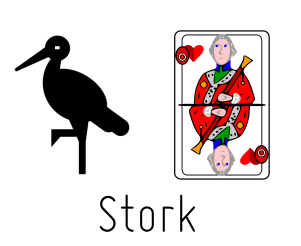 The Top Lenormand Area.
The Top Lenormand Area.
Each card also has an icon representing a card from the Petit Lenormand and an inset of the corresponding German-suited card at the top and bottom edges of the card.
Cartomancy with a Lenormand deck does not allow for reversals, and uses a smaller spread of cards than tarot, which allows the deck to be mostly unchanged, despite being only half the size. If a card would be drawn “reversed,” instead the other half of the card is drawn. And the fact that the probability of a specific next card is reduced twice as fast is less noticable with only two or three cards drawn total.
The “man” and “woman” cards have both been replaced with the “person.” This is common in modern Lenormand decks, but if you would prefer to read masculine and feminine qualities from the cards, the man is paired with the ace of hearts inset and the woman is paired with the ace of leaves inset. Alternatively, one can be identified with the querent specifically before the reading, and the other left free to interpretation.
Das Spiel der Hoffnung
If the cards are laid out in a 3 x 6 grid, upright and from left-to-right and top-to-bottom by sequence number, the 18th century “Game of Hope” can be played on the resulting board, treating the top and bottom half of each card as a separate space. This determined how the Lenormand cards were paired onto single cards.
The Deck
Putting it all together, we have a spreadsheet that looks like this:
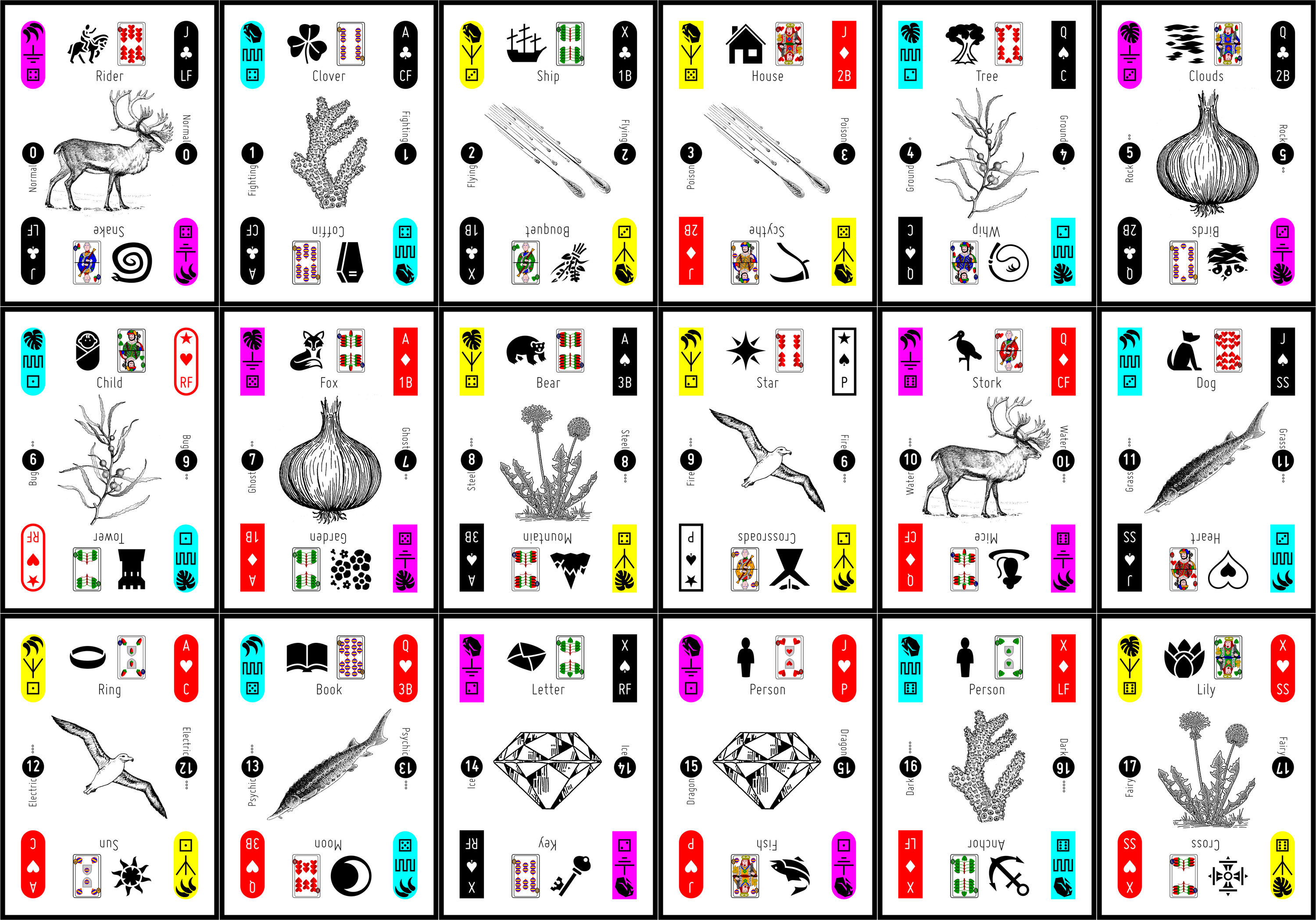 The full minideck.
The full minideck.
Practical Considerations
Go-First and Intransitive Dice
It took a bit of work to find a set of intransitive dice and a set of go-first dice that could be overlaid in the way I wanted. The sets chosen are both “palindromic,” although I couldn’t say if that’s why they worked out.
Embedded Cards
The most similar modern deck to the prototype of the Petit Lenormand is the one used to play Skat. However, in the intervening time,6 the deck has been further stripped of its sixes! So I found a promising SVG set of cards and then recreated (and uploaded) the ones I needed.
However, the information in the German card insets is strictly redundant, so I may remove them in a future revision.
Layout Decisions
Initially, I tried to pack information onto each card, more and more sets and subsystems. Can I have a border that changes style with one factor and color with another? Can I add “coins” of varied quantity and metal? (The coins, of course, corresponding to the factors that make 18 a semiperfect number…)
I made myself a few rules of thumb that simplified things greatly:
- If information is important, it should appear in two places on the card.
- If information appears in multiple places, it can be shown smaller than if it only appeared once.
Suppose I wanted to add clue weapons to the card. Before these rules, I would tell myself “sure, the lower right corner has space” (for example). But now, I have trapped myself: I either find two places to put the weapon, or I give it a whole ½” square. And one ½” square could hold four ¼” squares, so how much do I really want clue weapons? Do they add any information that couldn’t be mapped to roll or sequence?
Software
I considered trying to link the spreadsheet I’d planned the deck in as a data source in LibreOffice. Then, theoretically, I could lay them out as business cards or return address labels and have it fill in from there. (I mention this here only because it may in fact turn out to be a better interface for others attempting similar projects.)
What I actually did was export the spreadsheet as CSV, create a single mock-up card, and write a Perl script to fill in the template card for each line of the spreadsheet. This wasn’t as bad as it could have been because Inkscape (and SVG in general) allows you to nest SVG by referencing external files. But this nesting is fragile, so ultimately I converted them to PNG files with:
$ inkscape --export-type="PNG" --export-dpi=300 *.svgbefore assembling them onto pages for printing with LibreOffice Draw.
I’ve shared the code and all the intermediate files in a GitHub repository. The template and generating script are in /cards/, the PNG files are in /pngout/, the assembled file for printing is /pages.pdf, and the spreadsheet in which I incrementally worked out the system is in minideck.ods.
Printing
The cards are “poker card” sized, 2½” x 3½”. This constraint nominally comes from the Buttonshy challenge, but is also a convenience: this is the same size as a Magic: the Gathering card. So for a first draft, I can print the cards cheaply and sleeve them with extra Magic cards for stiffness.
Even though I’ve optimized this project for easy printing (two sheets, cheap paper), I don’t have ready access to a color printer (and the margins may be too narrow for some home printers). So if I’m already sending them out to be printed online, it might be just as easy to print them on nicer stock, cut and trim the edges with a guillotine, and so on.
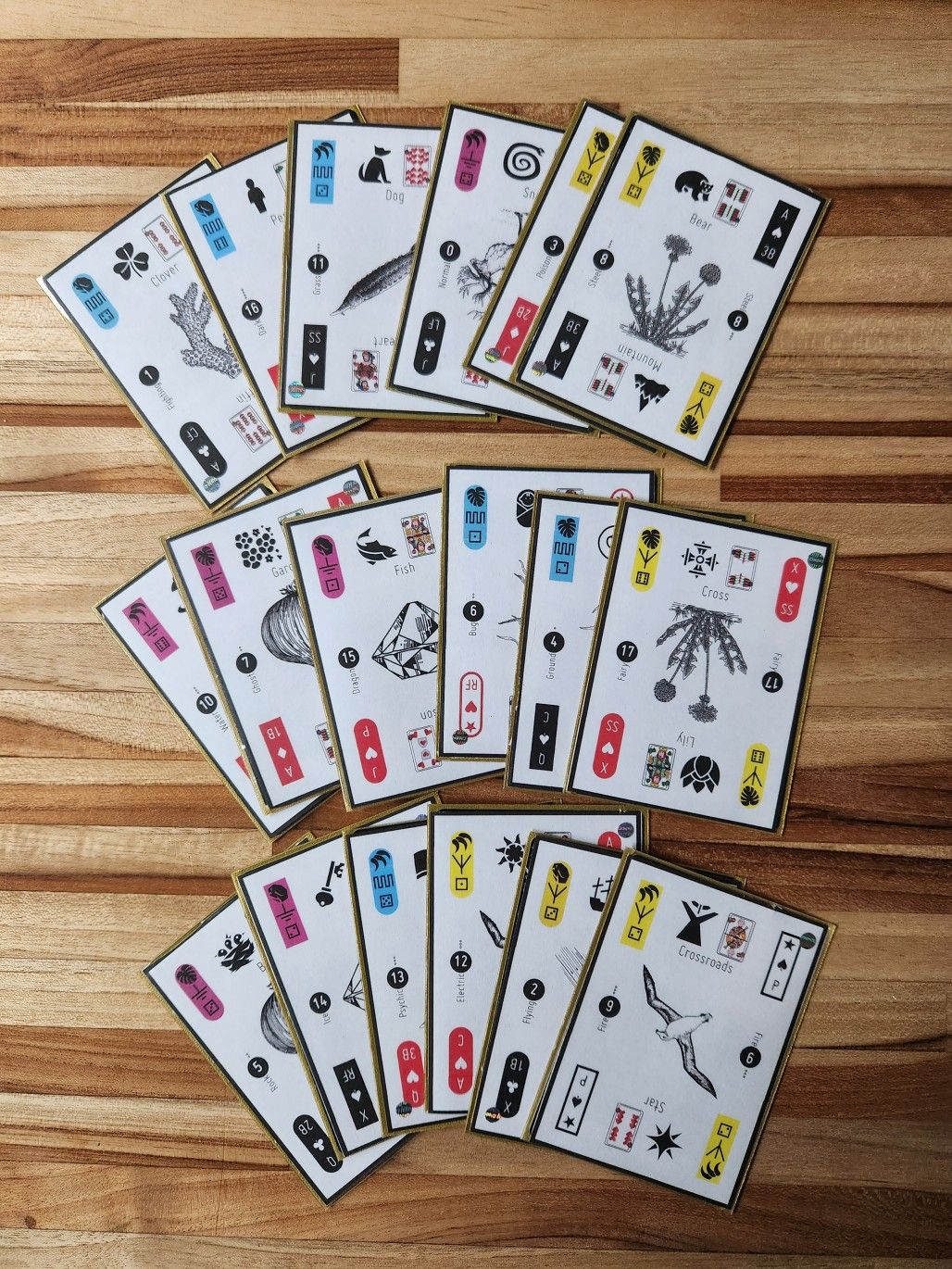 I did that first, cheaper option. It's very satisfying as an object.
I did that first, cheaper option. It's very satisfying as an object.
Sources
The font is Miso, which I chose for its elegance and compactness.
The German card insets are by Gunter Gerhardt (except the sixes), used under a CC BY-SA 3.0 license.
Most of the icons are from game-icons.net:
- Vegetable, Rider, Snake, Clover, Bouquet, House, Clouds, Birds, Star, Crossroads, Dog, Heart, Ring, and Person icons are by Delapoite.
- Animal, Mineral, Coffin, Ship, Scythe, Tree, Whip, Tower, Garden, Mountain, Mice, Sun, Book, Moon, Letter, Key, Anchor, Lily, and Cross icons are by Lorc.
- The Bear icon is by cathelineau.
- The Fox icon is by Caro Asercion.
- The Fish icon is by “various artists,” but ultimately the Swedish Road Administration.
These are all used under a CC BY 3.0 license, except the Fish icon, which is CC0.
Two icons are from the Noun Project:
- The Child icon is by Firza Alamsyah.
- The Stork icon is by Brand Mania.
Both of these are used under a CC BY 3.0 license.
Illustrations are from public domain sources:
- Albatross, Caribou, Sturgeon, Dandelion, Onion, Diamond, and Coral illustrations are from the Pearson Scott Foresman collection.
- The Sargassum illustration is from Meyers Lexikon.
- The Meteor illustration is adapted from Popular Science Monthly vol. 1.
Remaining work is by myself (Air, Land, and Sea icons, adjustments to illustrations, and the general composition). The cards are released under a CC BY-SA 4.0 license. This document and the supporting code and templates are released under the same, to the extent that any of it might be protected by copyright.
It’s not the only one of its kind, but it’s the one I encountered first.↩︎
Somewhat awkwardly, the Minideck is actually a poor direct substitute for most of Buttonshy’s other games, which commonly have lots of writing on the cards or rely on specific graphics.↩︎
To be sure, you can buy it at cost.↩︎
This is of course, completely unnecessary for the described purpose of go-first dice. Any three cards drawn from the same deck accomplishes the same result. But this way, each player has their own deck.↩︎
This is an idea that I’ve been kicking around for a while.↩︎
Der Spiel der Hoffnung is actually only about ten years earlier that Skat. Clearly stripping decks was fashionable at the time.↩︎